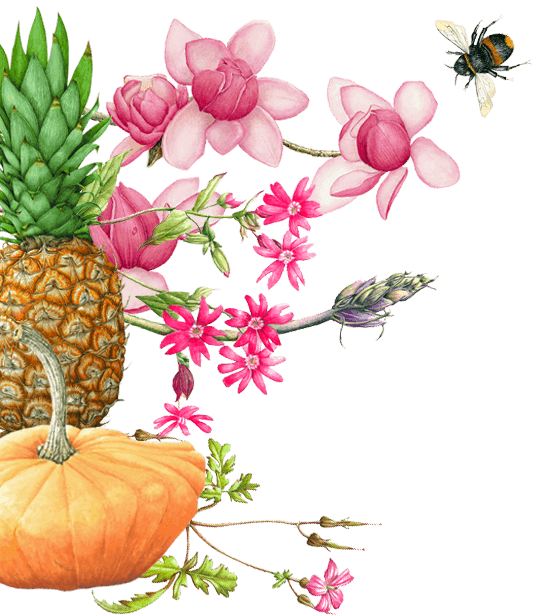Water, Woodland & Livestock by Oliver Brooks-Adams
- 4th Mar 2020
As the dreary drudgery of winter subsides ever so slightly, the Heligan Ranger Team can again lift their sodden heads above the proverbial parapet to assess the year's damage once more. The effects of such wet and windy weather are felt right across the Estate, from water-ways full to bursting to wind-blown trees caught up in the canopy; the task ahead is to clear up the site, making full use of any produce that is generated as a result of our work (timber, fire wood, hurdles for fencing, coppice for bean poles, wood chip for mulch etc.).
Beyond the post-winter clearance work lies pre-spring clearance work - they do say variety is the spice of life! As you walk around the Estate, you’ll see sections of understorey in the woodland have been cleared to make way for spring flowers and to achieve a mosaic of different habitats capable of supporting a diverse range of wildlife.
Finally, the Ranger Team have been lending a hand in the management of our rare breed livestock, working towards a system of management that will offer both health and ecological benefits beyond those found in regular grazing regimes.
Water: Drains, Ditches and Dikes
Water management is crucial to a wooded valley-site such as Heligan. The aim is to provide slow, clean water across the landscape and to avoiding gushing channelled water that brings with it the threat of erosion and deposition. Our paths are very susceptible to erosion and as with many things in life, once it occurs the risk of it reoccurring increases dramatically. This winter, the Ranger Team have been busy clearing drains and diverts of debris in an attempt manage this threat, and to provide a healthy fresh-water ecological network at the bottom of the Lost Valley in our various ponds, pools and lakes. The Dipping Pond and the largest of the lakes have also been cleared of vegetation, allowing light and oxygen back into the water to sustain a healthy fresh-water ecosystem and the wildlife that consequently supports. Clearing the watercress (Nasturtium officinale) from the Dipping Pond for example, has allowed space for the marsh marigold (Caltha palustris) to return, bringing with it its striking yellow flowers (a scarce commodity at this time of year, one which the pollinators of the world will greatly appreciate, I’m sure!).
Woodland: Clearing, Coppicing and Crown-Lifting
Winter is the time to really get stuck into woodland management. Between the storms and the wind, the Rangers have been out thinning, felling and clearing areas for a number of benefits. The removal of sickly trees provides the remainders with more space, light and room to grow on, free from the threat of disease or infection. Removing selected trees also helps to maintain light levels in the understorey, a crucial part of woodland management. Unmanaged woodlands often evidence dark, dank understoreys with little growing to support native wildlife. The woodlands at Heligan are managed purposefully to provide a diverse array of habitat that will ultimately support the most amount of native woodland species. Alongside this, the Rangers are also continuing the traditional woodland management techniques that have been employed on the Estate for hundreds of years. Coppicing (a traditional method of woodland management which exploits the capacity of many species of trees to put out new shoots from their stump or roots if cut down) has been extensively carried out in the woodland between Oak End and Butlers Path – be sure to keep an eye out for next year’s bean poles as you pass by! Finally, crown-lifting in various strategic spots around the Estate ensures our visitors have access to grand, sweeping views across the beautiful south Cornish landscape and down towards Mevagissey.
Keep a look out for bluebells (Hyacinthoides non-scripta), alliums, pink campions (Silene dioica), primroses (Primula vulgaris) and a host of other early-flowering spring flowers as they race to tentatively extend their foliage above the woodland floor.
Livestock: Rooting, Raining and Reigning
One of the many pleasure’s life at Heligan affords is the daily contact with some of the rarest and most cherished breeds of livestock this country can lay claim too. It is nothing but a pleasure to work with such knowledgeable, passionate and caring stockmen (and women!) and the Ranger Team have been studiously learning a great deal from them over the winter months. On the ground, it hasn’t felt like its stopped raining since October. This presents myriad challenges, not least what to do with over-wintering livestock whose requirements, unsurprisingly, don’t diminish in this tough period!
The productivity of the livestock at Heligan is one of the most unique and fascinating elements of our management here. The cattle are used to graze fields on a rotational basis, providing the ecological conditions necessary for a flush of wildflowers come the spring. Similarly, the pigs are involved in the cultivation of wildflowers too. Over on West Lawn our visitors can see them in action, nosily rooting around in the soil, no-doubt searching for food but in reality, doing a marvellous job of ploughing without the dependency on fossil fuels that tractors stipulate! When the weather turns and the pigs move off the lawns, expect to see wildflower meadows burst up and into action thanks to the cultivations of our resident ‘bio-ploughs’!
Finally, no update would be complete without giving the ever popular and beloved Courage (our horse) a fair mention. Louis, the stockman tasked with training Courage, is working closely with him towards the ultimate objective of being able to use him to extract timber from our woodlands in the least impactful way possible (I.e., without the use of heavy machinery). His progress is encouraging, and we hope to be able to put him to work in the near future.




